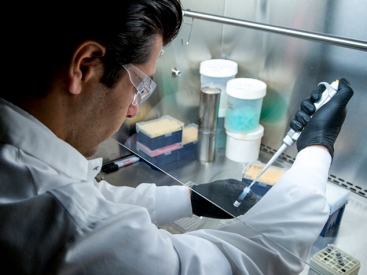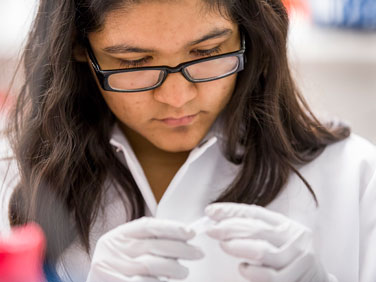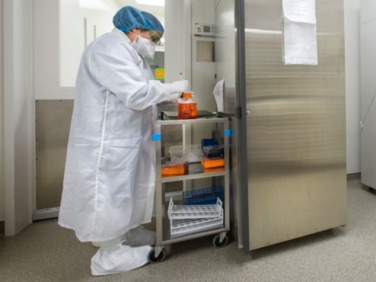Cell Engineering
Genetic Engineering
The Adair lab is focused primarily on developing clinical applications of blood stem cell engineering at the DNA level. Since our blood replenishes itself over and over again during the course of our lifetime, cell engineering must happen in the DNA to ensure that a one-time treatment can render a lifetime of therapeutic value. Blood stem cells are responsible for making every type of blood cell needed by the body, making them an attractive target for engineering. There are multiple tools for engineering blood stem cells, but not every tool works for every disease application. In addition, blood stem cells are extremely rare and dispersed throughout the body in our bone marrow, which means accessing them to engineer them is technically complicated. Much of the ongoing research within the Adair lab is centered on refining the blood stem cell engineering process to alleviate these difficulties and bring gene therapy treatments to the forefront of accepted medical practice.
Of course, tools and techniques developed for blood stem cells have applications in other types of cells and tissues. Currently we are also developing methods to engineer immune cells including T cells and B cells.
Our list of disease targets is ever-growing and currently includes Fanconi’s anemia, sickle cell disease, HIV infection, inherited immune deficiencies, thalassemia and respiratory virus infections including influenza, RSV and Covid-19.

Fanconi Anemia
Fanconi anemia (FA) is a monogenic inherited disease affecting DNA repair which has many clinical manifestations. Cell engineering for the treatment of FA is hampered by extremely low numbers of blood stem cells and significant risk of loss when these fragile cells are manipulated.
The Adair lab previously developed modified protocols to preserve the few numbers of fragile stem cells available from FA patients by incorporating agents to prevent oxidative DNA damage and accomplish successful gene transfer with minimal manipulation in as short as 24 hours. This work led to the first phase I clinical trial in FA patients using portable cell engineering technology (gene-therapy-in-a box) developed by the Adair lab. Dr. Adair coordinated a clinical trial investigating the potential for engineered blood stem cells to treat FA patients who have defects in the FANCA gene, the most common FA genetic defect in the U.S. [National Clinical Trials registry: NCT01331018].
Our lab also works closely with the International Fanconi Anemia Gene Therapy Working Group to develop new cell engineering approaches in this uniquely challenging disease setting. Current FA research uses mouse models of the disease to evaluate in vivo gene delivery, as well as modified protocols for ex vivo gene transfer which increase numbers of gene modified cells available for transplantation.

Hemoglobinopathies (Disorders of red blood cells including sickle cell and thalassemia)
Approximately 1.1 million births worldwide are at risk for hemoglobinopathies every year, effecting as many as 25 in every 1,000 births in geographic regions where malaria is prevalent, owing to a natural resistance to malaria infection conferred by hemoglobin (Hb) genetic variance. In developed countries, patients live with chronic disease unless treated with a bone marrow transplant from a compatible healthy person. However, even bone marrow transplant comes with the risk of infections or rejection of the bone marrow, or negative reaction of the healthy bone marrow against the hemoglobinopathy patient. If a compatible healthy person cannot be found, patients are at risk of serious side effects which can be fatal. In underdeveloped regions, survival is significantly lower. For example, in Africa, childhood mortality is 40% in patients with hemoglobinopathies, compared to 16% in all children.
In collaboration with two international clinical sites, the Joint Clinical Research Centre in Kampala, Uganda and the Christian Medical College in Vellore, India, our lab is developing sustainable methods for blood stem cell engineering to treat hemoglobinopathy patients. We do this work as part of the International Initiative for Cell and Gene Therapy administered by the nonprofit organization Caring Cross, for whom Dr. Adair serves on the scientific advisory board.
To facilitate this work, our lab developed technology to permit automated collection and engineering of patient blood stem cells in a small, mobile footprint that could be used in the patient’s room [Adair et al., Nature Communications, 2016]. While this technology will facilitate clinical trials for patients in these countries, it will not come close to the kind of distribution required to make this therapy readily accessible to millions of patients. The Adair laboratory also develops engineered nanomaterials that can deliver the machinery required for blood stem cell engineering inside the body. The ultimate goal of this work is to safely and feasibly administer cell engineering as an injection in the field.

HIV and respiratory viral infections
Human Immunodeficiency Virus (HIV) is a worldwide epidemic that has only been cured in three patients to date with a complex and unique treatment regimen that will not be possible in all HIV+ patients. Respiratory viral infections such as flu, RSV and the 2020 covid-19 pandemic wreak havoc on the world at large year after year, impacting human survival and burdening healthcare systems. Vaccination is one strategy that can thwart these kinds of infections, but the results can vary considerably: there is no effective vaccine that can prevent HIV or RSV infection, flu shots must be given every year to keep up with influenza virus evolution and spread, and we await the results for recently approved Covid-19 vaccines.
Decades of research from thousands of scientists and hundreds of laboratories have given us tremendous information about how our immune systems work and why some vaccines fail. In the last two decades, researchers have shown that engineering T cells can direct the body’s immune system to seek-and-destroy harmful cells such as cancer cells and HIV-infected cells. We also know that B cells in our body are what produces antibodies that tell T cells what to attack, and that we can engineer B cells to make specific antibodies. But again, the current state-of-the-art for these kinds of treatments is complicated and expensive, which means it is not readily available for patients and unsustainable in current healthcare systems.
Our current research focuses on whether the same tools and techniques developed by our lab for blood stem cell engineering can be repurposed for engineering T cells and B cells.

© 2025 Fred Hutchinson Cancer Center, a 501(c)(3) nonprofit organization.